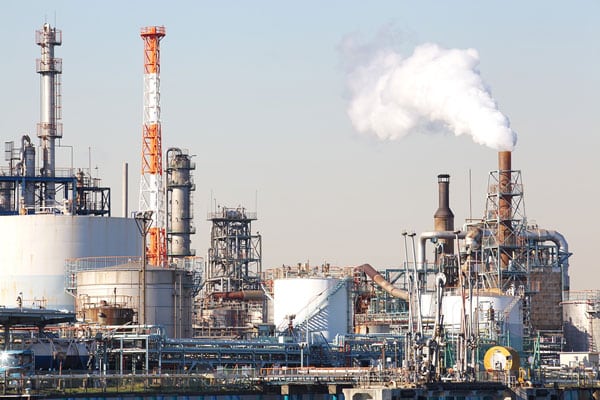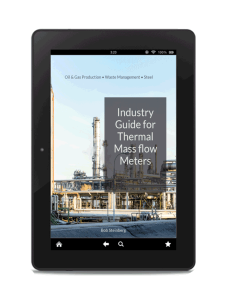Many processes are integrated into crude oil refining and natural gas processing and require accurate gas measurement. Thermal mass flow meters are an excellent choice for measuring air and gas flows to various process units.

Sulfur Recovery Unit
In natural gas processing and refining of high-sulfur crude, hydrogen sulfide (H2S) is removed and converted to elemental sulfur using the Claus process. This process involves the reaction of H2S with the oxygen (O2) present in the air to create sulfur dioxide (SO2) and water (H2O). The H2S and SO2 then react with each other to produce sulfur (S). The amount of air reacted with H2S must be accurately controlled, so 1/3 of the H2S is converted to SO2. This reaction creates the desired 2:1 ratio between H2S and SO2. Too much air establishes the formation of unreactive sulfur trioxide (SO3). Too little air forms less than the stoichiometric amounts of H2S and SO2, resulting in lower S yields.
The thermal mass flow meter is the desired choice for measuring air mass flow. Its primary advantage is direct mass flow measurement without pressure and temperature correction combined with high reliability.
Process Heaters
There are numerous process heaters and other combustion sources in a refinery or gas production plant. By operating at the desired air-to-fuel ratio, the most efficient control of the heater is obtained. Too much gas and the combustion runs rich, and un-combusted fuel is emitted. Too much air means that the excess air is unnecessarily heated, reducing the combustion efficiency.
Thermal mass flow meters frequently measure air flow and gas fuel flow to combustion sources to help achieve the most efficient combustion.
The Sage white paper “Combustion Efficiency and Thermal Mass Flow Meters” explores using flow meters to achieve stoichiometric combustion, saving energy, and reducing pollutants.
Greenhouse Gas Emissions

The EPA requires that many facilities report greenhouse gas (GHG) emissions. Multiple methods exist for determining GHG emissions from combustion sources. One easy way is to measure and totalize the flow of natural gas consumed during the specified period and use EPA formulas to calculate GHG emissions.
A thermal mass flow meter can easily measure the natural gas flow, and the built-in non-resettable totalizer provides the total fuel consumption. While other flow meter types typically require significant piping modifications, this can be avoided using a thermal mass flow meter with an insertion probe. This meter style permits easy installation in the existing gas pipe.
Explore greenhouse gas emissions monitoring in applications of biogas, landfill gas, digester gas, and flare gas in the Sage white paper, “Greenhouse Gas Emissions Monitoring Using Thermal Mass Flow Meters.”
Gas Flare
A gas flare is a combustion safety device that burns off the excess gas or unintentionally released gas. Without a flare, the material is released into the atmosphere, creating an unsafe situation. Flares are used in gas production and oil refineries.
Important factors must be considered when using a thermal mass flow meter on flare lines. Due to the changing gas composition, the thermal mass flow meter will not provide accurate flow measurement of the flare gas emitted, and its use in the main flow header is not recommended. However, the thermal mass flow meter has applications in the individual flare headers. Due to the excellent flow velocity sensitivity, the thermal mass flow meter will detect the flow of the continuous sweep gas. In the event of a release to the flare system, the meter can indicate what process the unit is sending gas to the flare and detect if any valves have not entirely closed after the unit resumes regular operation.
Explore overcoming the challenges of using mass flow meters with gas flaring in the Sage white paper, “Flare Gas Measurement Using Thermal Mass Flow Meters.”
Thermal Mass Flow Meter Advantages
Thermal mass flow meters provide the following benefits:
-
- Direct mass flow measurement without the need for pressure and temperature correction
- Excellent flow velocity sensitivity having the ability to measure flow rates that other flow meters cannot detect
- Easy to retrofit into existing piping with the insertion probe
- High turndown rates provide excellent rangeability
- A simple method to verify the calibration of the meter

